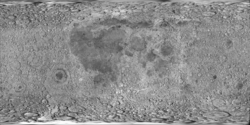Ching-Te (kráter)
| Kráter Ching-Te | |
|---|---|
| Souřadnice na Měsíci | |
| Selenografická šířka | 20,0° S |
| Selenografická délka | 30,0° V |
| Další údaje | |
| Typ kráteru | jednoduchý |
| Průměr kráteru | 3,9 km [1] |
| Hloubka | ? km |
| Colongitudo | 330° |
| Eponym | čínské mužské jméno |

Ching-Te je malý impaktní kráter nacházející se v hornaté oblasti východně od Mare Serenitatis (Moře jasu) na přivrácené straně Měsíce. Má průměr 3,9 km. Není pojmenován dle zvyklostí podle osoby, nýbrž podle čínského mužského jména.[1][2] Má kruhový obvod a miskovitý tvar. V údolí cca 20 km východně se nachází místo přistání americké expedice Apollo 17.[1]
Jihozápadně leží horský masiv Mons Argaeus a kráter Fabbroni, severně kráter Clerke a soustava brázd Rimae Littrow.
Odkazy
Reference
- ↑ a b c Antonín Rükl: Atlas Měsíce, druhé české vydání, Aventinum (Praha 2012), kapitola Römer, str. 76, č. mapového listu 25, ISBN 978-80-7151-269-1
- ↑ Crater Ching-Te on Moon Gazetteer of Planetary Nomenclature, IAU, USGS, NASA (anglicky)
Literatura
- RÜKL, Antonín. Atlas Měsíce. 2. vyd. Praha: Aventinum, 2012. ISBN 978-80-7151-269-1.
Externí odkazy
 Obrázky, zvuky či videa k tématu Ching-Te na Wikimedia Commons
Obrázky, zvuky či videa k tématu Ching-Te na Wikimedia Commons - Kráter Ching-Te Archivováno 2. 3. 2018 na Wayback Machine., Moon-Wikispaces.com (anglicky)
- LAC 42, mapa 1:1 000 000 (Lambertova projekce)
Média použitá na této stránce
cylindrical map projection of the Moon. The Moon's whole surface was mapped by the Clementine spacecraft in 1994, here North is at the top. The dark floor of crater Plato is at the middle top above Mare Imbrium, while the bright floor and rays of crater Tycho is near the middle bottom below Mare Imbrium. Mare Procellarum is at the near left, and Mare Tranquillitatis is just right of centre and Mare Crisium is at the near right. The far left and far right show the contrast of the mostly cratered farside with small isolated mare.
Craters Littrow, Dawes and Vitruvius with Apollo 17 landing site (detail of LROC - WAC global moon mosaic)


